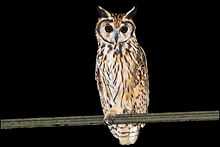Striped owl
| Striped owl | |
|---|---|
 | |
| Conservation status | |
| Scientific classification | |
| Kingdom: | Animalia |
| Phylum: | Chordata |
| Class: | Aves |
| Order: | Strigiformes |
| Family: | Strigidae |
| Genus: | Pseudoscops (disputed) |
| Species: | P. clamator |
| Binomial name | |
| Pseudoscops clamator (Vieillot, 1807) | |
| Synonyms | |
|
Asio clamator | |
The striped owl (Pseudoscops clamator) is a medium-sized owl with large ear tufts and a brownish-white facial disk rimmed with black. Its beak is black, and it has cinnamon-colored eyes. It has shorter, rounder wings than most of its close relatives. The upperparts are cinnamon with fine black vermiculation and heavy stripes. The underparts are pale tawny with dusky streaks. It is native to South America, and parts of Central America.
Its systematic placement is not resolved. Different authorities place it in Asio, in Pseudoscops together with the Jamaican owl, or more rarely into the monotypic genus Rhinoptynx.
Description
The striped owl is a relatively large species with prominent tufts of elongated feathers on the crown resembling ears. It is 30–38 centimetres (12–15 in) and weighs from 320 to 546 g (11.3 to 19.3 oz).[2] Its head, back, hot wings and tail are brown with black stripes and small markings while its underpants are buff-coloured with heavy black streaking on the breast. The facial disk is pure white with a thin black border.[3]
Distribution and habitat
The striped owl is native to much of South and Central America. Its range is not well known, perhaps because it is nocturnal and not easily seen, but it is known from Argentina, Belize, Bolivia, Brazil, Colombia, Costa Rica, Ecuador, El Salvador, French Guiana, Guatemala, Guyana, Honduras, Mexico, Nicaragua, Panama, Paraguay, Peru, Suriname, Trinidad and Tobago, Uruguay and Venezuela. It uses a variety of habitats, including riparian woodlands, marshes, savannahs, grassy open areas, and tropical rainforests. It can be found from sea level to 1,600 metres (5,200 ft) and above.[1]
Status
The striped owl has a very large range and its population is believed to be stable. It faces no particular threats, and as a result, the IUCN has listed it as being of "Least Concern".[1]
References
- ↑ 1.0 1.1 1.2 BirdLife International (2012). "Pseudoscops clamator". IUCN Red List of Threatened Species. Version 2013.2. International Union for Conservation of Nature. Retrieved 26 November 2013.
- ↑ Owl pages (2011).
- ↑ Thurber, Walter A., Rebecca Lohnes, and Thomas S. Schulenberg (2009). "Pseudoscops clamator: Striped Owl". Neotropical Birds Online. Cornell Lab of Ornithology. Retrieved 2013-12-22.
External links
| Wikimedia Commons has media related to Pseudoscops clamator. |
- Striped Owl videos on the Internet Bird Collection
- Stamps (for Suriname) with RangeMap
- Photo-Medium Res; Article borderland-tours
- Striped Owl photo gallery VIREO
